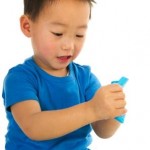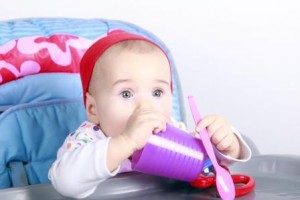Has anyone other than me struggled to get a 17 month old to “obtain toy with stick?” How many 24 month olds have you been able to get to  cooperate with “walks approximately on line” or “attempt to fold paper?”
cooperate with “walks approximately on line” or “attempt to fold paper?”
Some items on developmental assessments that are just challenging to administer. You can find guidance in the assessment manuals (which if you haven’t read, please do), but the manuals don’t always provide information about what the test item really means in development. These items also should not move directly from the assessment tool to the IFSP as an outcome because a child missed them. When you understand that test items are a demonstration of a child’s understanding and abilities, it will help you interpret assessments more functionally and write better IFSP outcomes.
Here are my top 4 goofy assessment items and some information about what these items really tell us:
#4 – Walks approximately on line (24 months, ELAP)
The challenge I always had with this one was getting the toddler to understand what I wanted him to do when I presented him a line of tape on the floor. It’s just not that fun and is pretty abstract for a 2 year old. It is an imitation task and gives us information about balance, motor planning and coordination. If we could observe children in multiple settings for assessment rather than see them for an hour in a contrived setting, then I think this one would be much easier to evaluate because you might see the child imitate peers doing this, walk along a line in the parking lot on his way to the park, etc. If you can’t get the child to cooperate, ask his sibling to show him how to do it or ask for the parent’s help.
 #3 – Attempts to fold paper (24 months, ELAP)
#3 – Attempts to fold paper (24 months, ELAP)
This fine motor and cognitive item used to make me internally grimace at each assessment. The toddler would even look at me like “why am I doing this?” When you administer this item, you show the child how to fold the paper in half then give him another piece of paper and ask him to fold it. He gets credit if he turns the paper in an attempt to fold it. This item puzzles me about what it shows us, but I think it helps us see if the child can understand the command, figure out how to orient the paper to imitate the task, hold the paper between his fingers, attend and persist, and use two hands together. He also has to use his eye-hand coordination to do something he saw done from a different angle. All of these skills are more important than the task but the task itself is important because it has been tested on many 24 month olds and they should be able to do this at this age – but it is not a goal of early childhood to fold paper.
#2 – Obtain toy with stick (17 months, ELAP)
This is definately one of my favorite goofy items. I think that, in 15 years of assessing toddlers, I probably had 3 children do this one. It was probably due to my difficulty administering the item, and maybe to the stick quickly turning into a dangerous object. This item shows us that the child can imitate, follow a direction, coordinate his movements to bring the toy to him with the stick, and understand the use of a tool (the stick) that is not connected to the item he wants. It also shows us how the child problem-solves and persists to get this needs met. The ELAP manual says that a child should be able to get the toy with the stick by 20 months. I think this is similar cognitively to how a child problem-solves getting his cup that’s out of reach by pulling a chair over to the counter and climbing up to get it.
#1 – Stirs with spoon in imitation (10 months, ELAP)
Yes, I have actually heard interventionists tell parents that a next skill for a child is learning to stir with a spoon. What? This item shows a child’s ability to imitate an unfamiliar action, coordinate his wrist and finger movements, combine two objects, and perhaps use two hands together if he holds the cup and spoon. It is not, in and of itself, an important skill. Please don’t tell parents to teach their children to stir. Please do explain to them what this skill tells us and how it relates to the child’s other strengths and needs.
Administering test items as instructed is important for the validity of test results. Just because items might seem goofy doesn’t mean that they aren’t important to determining how a child’s development compares to other children on the test. Follow the instructions and administer the items correctly, then explain to the parent what the items are assessing and how they inform us about why the child can or cannot do certain activities in his everyday life. Even the goofy items can help you understand a child’s development if you put them in the right context.
What are your favorite (or least favorite) test items? How do you explain them to families during the assessment?


